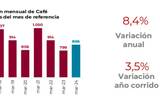Why do some producing areas produce fixed varieties of coffee?
At present, some coffee-producing countries basically only produce some fixed varieties of coffee, such as Brazil mainly produces bourbon, Jamaica Blue Mountain mainly produces iron pickup, and so on.
In fact, in many cases, it is due to the spread of coffee varieties, spread to the local and can have a good adaptability in the local environment, so it has become one of the main local production varieties. In addition, some varieties are new varieties developed by the National Coffee Research Institute and are vigorously promoted and planted in the country.

In some countries, coffee varieties are studied because of the major leaf rust disaster in the 19th century, so it is necessary to develop more disease-resistant coffee varieties. In addition, they also hope to develop a new generation of coffee varieties with high yield and disease resistance. and a new generation of coffee varieties with good flavor.
According to historical records, at the end of the 19th century, there was the largest leaf rust disaster in history, destroying almost all coffee trees in the Eastern Hemisphere (much of Asia and Africa). After that, Arabica coffee varieties were transferred to the Western Hemisphere (American region) for cultivation.

For this leaf rust disaster, some coffee producing countries began to turn to planting stronger varieties Robusta, while others began to set up national coffee research institutes to develop disease-resistant coffee varieties. However, because of the characteristics of the varieties developed through investment funds, the government is bound to vigorously promote national cultivation, so these countries mainly produce new varieties developed by the country.
At present, the most common laboratory varieties are SL28, SL34 and Ruiru 11 of Kenya, H1, which is a common F1 hybrid in Latin America, and Catuai, which is now common in the world.
Kaduai Catuai
Kaduai Catuai is a hybrid between the highly productive New World Mundo Novo and Kaddura Caturra. It is a variety produced by the Institute of Agronomy of the State of Sao Paulo (IAC) in Campinas, Brazil. Kaduai has the characteristics of high productivity and small size, so it can be planted intensively. Because of its characteristics, it is currently planted in many countries in the Americas.
SL28 、 SL34 、 Ruiur11
In the late 1930s, the Kenyan government commissioned the former Scott Agricultural Laboratory Scott Laboratories (now the National Agricultural Laboratory) to select 42 varieties to study their yield, quality, drought and disease resistance, and named 42 varieties after the Scott laboratory's abbreviation SL+ number. In the end, it was found that the SL28 and SL34 varieties had good quality and flavor, and high yield, but were prone to coffee disease.
Ruiru 11 uses Katim as the female parent, while the male parent is a complex hybrid. In 1968, an outbreak of coffee berry disease (CBD) in Kenya reduced the production of raw coffee beans by about 50%. The Coffee Research Institute in Ruiru began a breeding program to produce varieties that are immune to CBD. It took many years for breeding experts to develop the male parent of Ruiru 11, which covers the advantages of K7, SL28, N39, Rume Sudan and other varieties. In 1985, Ruiri 11, with its local name, was launched. This variety has high yield, good quality, resistance to berry disease and certain resistance to leaf rust, but it is vulnerable to nematodes.
Therefore, at present, when you buy Kenyan coffee beans, you often see SL28, SL34 or Ruiru 11. For example, Asalia coffee beans in Kenya, which are used in front street coffee, use SL28 and SL34 varieties.
H1
The H1 variety was selected by the F1 coffee variety breeding program to find ways to combat the increasingly rampant coffee disease. The French Centre for Agricultural Research and Development (CIRAD) and the Central American Coffee Organization (ROMECAFE) jointly launched a new variety breeding program.
It is assisted by the American Institute of Agricultural Research (IIAC) and the Tropical Plant Research Centre of Costa Rica (CATIE). CATIE selected Kaddura, Kaduai, Katim, Sachem (a hybrid of Verasaci and Tim) and an ancient African wild variety Rume Sudan from hundreds of coffee varieties. Pollen from T5296 (the offspring of Sachem) was extracted and smeared on the stamens of Rume Sudan by artificial pollination.
After 5 years of efforts, CATIE has harvested a total of 100 different Cenozoic generations, and 20 of them with excellent performance were selected for breeding. The primary generations of these F1 not only have stronger disease resistance and drought tolerance, but also have the advantages of higher yield and better flavor.
The H1 variety is the first generation of F1 hybrid variety group, which is bred by the hybrid of Tmur5296 (Satchmo) and Sudan Rume (Lumei Sudan) of the first generation F1 hybrid series. This coffee is of good quality and flavor, and its yield is 22% higher than that of other traditional American varieties. It is highly resistant to rust, but is vulnerable to nematodes. At present, H1 varieties are more common in Costa Rica, and the Costa Rican Mozart coffee beans of Qianjie Coffee are H1 varieties.
Important Notice :
前街咖啡 FrontStreet Coffee has moved to new addredd:
FrontStreet Coffee Address: 315,Donghua East Road,GuangZhou
Tel:020 38364473
- Prev

Starbucks Lucky both exploded: one family evaporated hundreds of billions overnight, and one family turned from profit to loss
▲ Click to pay attention| Daily Boutique Coffee Culture Magazine Coffee Factory has just entered May, which is an unpleasant start to the new season for coffee giant Starbucks. On May 1, local time, Starbucks 'share price suffered an unprecedented stock price plunge in the U.S. stock market, falling nearly 18% at one point. As of the close of the day,
- Next

Production and exports decrease! Colombia FNC accuses government of inaction
Recently, the Colombia Coffee Growers Alliance FNC released its March coffee export report. Although the reported data is good, it is still in trouble in the future. According to a report released by the FNC, in March 2024, Colombia's coffee production was 866,000 bags of 60 kilograms, an increase of 8.8 percent over the same period last year
Related
- What ratio of water temperature and ground does the smart cup method use to press coffee? The difference between brewed coffee and filtered coffee?
- What is the standard process for the purpose of coffee cup testing? What is the difference between hand-brewed coffee and cup testing?
- How to use hand-brewed coffee paragon small golden balls? How does cold coffee lock in the aroma of coffee?
- Is American coffee black? What is the difference between American coffee and drip coffee?
- Unexpected! Well-known tea beverage brand Lele Tea will withdraw from the Zhengzhou market!
- Starbucks enters the fashion and beauty industry?! Netizen: Give me an ice American eye cream
- Why can American refills for free? The difference between Americano and American drip pot coffee
- Being chased out of the rain in front of Starbucks?! Store: Sheltering from rain under umbrellas poses a safety hazard
- The white moonlight has changed?! Lucky launches "Big Winter Pear American"
- Hand-brewed coffee three-stage method, high-sweet and universal brewing method to share! What does the high sweet water level of hand-brewed coffee mean?

